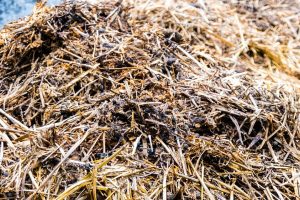One question that seems to crop up frequently between gardeners and allotment holders is which manure is better to use, horse manure or cow manure?
Cow manure is generally more liquid, hence cow pats rather than the distinct lumps that a horse produces but otherwise there is very little difference between them in terms of fertiliser nutritional value.
Nutritional Value (NPK) of Horse & Cow Manure
| Horse Manure | Cow Manure | |
|---|---|---|
|
Nitrogen Content |
0.7% | 0.6% |
|
Phosphorus Content |
0.3% | 0.4% |
|
Potassium (Potash) Content |
0.6% | 0.5% |
 Cow Manure
Cow Manure
Cow manure tends to be used by wise farmers on their land and the contents of slurry tanks (basically a tank to hold the cow manure and water until ready for disposal) are applied by spray from tankers as a liquid feed.
Because cow manure is more wet than horse, it’s often said that horse manure is better for wet soils, like heavy clays. It seems logical enough but when you think it through, the amount of liquid in the manure isn’t really going to effect the soil.
It really makes no difference whether you use horse or cow manure to add fertility and humus to your soil whatever the soil type so long as it is well aged or composted first.
Sometimes you can find a farmer willing to sell a load of cow manure from a barn mixed with straw. If offered this, then by all means accept as it can be used as the basis of a hot compost heap, a hot bed or just covered over to rot down for a few months before applying directly to the field.
Horse Manure
Horses however, are kept more as pets and in smaller numbers than cows. The average size of a dairy herd now being around 120. So whilst there is less horse manure about, the fact is that the average horse will produce between 8 and 9 tons of manure a year.
A livery stable with just 6 horses will be producing be generating around 50 tons a year of waste. That’s a lot of horse manure! Now if those horses were in the wild, roaming across many acres of land, the droppings would just rot down and become incorporated into the soil, returning fertility to pasture. However, our livery stable has but a few exercise paddocks and the stable itself.
Nitrogen Deficiency in Fresh Manure
The manure and urine is mixed with either wood shavings or straw and cleaned out into a pile, often along with neat droppings collected from the field. While the horse manure itself is a good fertilizer, the sawdust and wood shavings are not crop friendly. That’s because when wood breaks down in the soil, it requires nitrogen and a nitrogen deficiency occurs, which stunts the growth of crops.
To combat this problem, a nitrogen fertilizer could be added to the soil after horse manure is spread on it; or a nitrogen fertilizer could be added to the horse manure and sawdust or wood shavings mixture before being added to the soil.
Adding inorganic fertiliser to manure is really wasteful since the answer is to compost the manure pile. Often in just a few months but certainly less than a year, the bedding materials have broken down and the manure compost will add net nutrients as well as valuable humus to the soil.
The bedding present in the manure is a good “brown” component to compost and along with any other materials added to the compost pile, completely break down and become what many people call “black gold.”
Obtaining Horse Manure
Often stables are on the edge of towns or even within cities, so their waste problem can become your resource. Some canny stables will sell bags of rotted manure, some for a nominal price and some for as much as they can get but many if not most will be glad to let you have as much as you can cart away for free. I’ve even come across stables happy to deliver (locally) a trailer load.
Once you have the manure, if it is old and well rotted, feel free to spread it as a mulch onto the soil at any time, mixing it into the top six inches of soil prior to planting. But if you can still see bits of bedding or some of the droppings retain their integrity, then it needs to be composted further prior to use.
Using Large Amount of Manure
If you are lucky to have an awful lot of manure, feel free to add any volume to your soil as long as it is well rotted.
If, however, it still hasn’t finished and has some heat in it when piled do not spread it over the soil. Leave it under a tarpaulin until rotted or mix it into your compost bins to rot it down.
Using Fresh Manure
If you have a source of fairly fresh manure in volume, consider using it as a hot bed as an alternative, making use of the warmth whilst rotting down.



